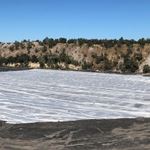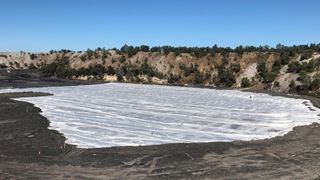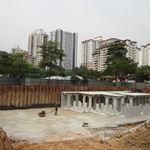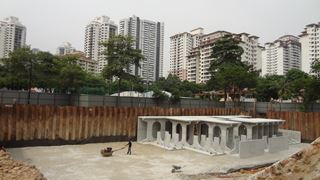Case story
Reinforced Mine Tailings Pond Closure in Huelva, Spain
Spain, Huelva
The Sotiel Coronda mining complex is located at Calanas in the province of Huelva (Andalucia), Southwest Spain. This was a huge deposit of pyrite mineral that had been extracted over centuries of mining in the area. The main mineral extraction activity was the processing of copper, lead and zinc, as well as the production of sulphuric acid.
Following completion of mining and processing activities in the area, the environmental company, EGMASA of the Regional Government of Andalucia (Junta de Andalucia) was made responsible for the reclamation and closure of the large pyrite tailings pond (surface area around 35 ha) from September 2005 to April 2006.
The challenge
The reclamation and closure of the tailings pond required the movement and placement of large volumes of tailings and subsequent fill. The tailings were very soft and extended to a depth approximating 18m. In many areas the surface of the tailings were saturated, while in other areas there was a crust on the surface of the tailings, but very low shear strengths existed at shallow depth below the surface.
Due to the extensive area to be reclaimed, the large volumes of fill to be moved, and the tight time schedule of the Client, large volume, heavy earth moving equipment had to be used. This posed a major technical problem as the heavy equipment had to traffic over the very soft tailings.
The solution
The solution was to construct a 1.0m thick stone-fill working platform over a layer of Polyfelt® PEC400 geocomposite reinforcement. Polyfelt® PEC400 is composed of high modulus polyester yarns in a composite structure and has an initial tensile strength of 400 kN/m in both the longitudinal and cross directions. The Polyfelt® PEC400 also acts as a geotextile separator preventing the intermixing of the soft tailings with the stone fill. The selection of this geocomposite reinforcement was determined on the basis of a detailed stability analysis of support for the heavy earth moving equipment over the very soft tailings deposit. Different possible loading scenarios were investigated before arriving at the final solution. Further, consideration was also given to the good resistance of this geosynthetic material to the effects of installation damage caused by the placement of large stones in the working platform.
The construction
The Polyfelt® PEC400 geocomposite reinforcement was placed starting at the edges of the tailings pond (the high points) and working inwards to the centre (the low point). Care was taken to ensure that any run-off water would not contaminate the new working platform.
The stone fill was back-dumped from the earth moving equipment and then bulldozed over the top of the Polyfelt® PEC400 geocomposite reinforcement to ensure there was minimal disturbance of the soft tailings below.
Across the top of the working platform a 0.5m thick layer of compacted clayey material was placed. This layer provided a smooth, stable platform for the subsequent placement of the geomembrane liner.
To prevent rainfall seeping into the contained mine tailings and prevent contaminants rising to the ground surface, a barrier consisting of a composite geomembrane/compacted clay liner system was employed. This consisted of a 1.5mm thick HDPE geomembrane cushioned between two layers of Polyfelt® TS80 geotextile protection, with a 0.5m thick compacted clay layer on top.
To drain any percolating rainfall, a 0.2m thick granular drainage blanket was installed on top of the composite liner system. First, a Polyfelt® TS20 geotextile separator was placed to ensure no intermixing of the clay layer and the granular drainage blanket occurred. Then, the granular dranage layer was placed, and finally, a Polyfelt® TS20 geotextile filter was placed on top. After this, a 0.5m thick soil covering was placed and the area vegetated. Extensive surface run-off drainage was also installed.
Section through the mine tailings pond closure.
Very soft, saturated tailings at certain locations in the tailings pond.
Placement of the granular fill working platform over the Polyfelt® PEC400 geocomposite reinforcement.
Partial closure of the mine tailings pond.
Installation of the Polyfelt® TS20 geotextile separator prior to placement of the granular drainage blanket.
Type of stone fill used as the working platform on top of the Polyfelt® PEC400 geocomposite reinforcement.





?w=150&h=150&action=crop)
?w=320&h=180&action=crop)


